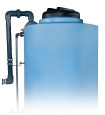Can you name one of the most common things companies forget to consider when purchasing a tank? Surprisingly, many operations don’t consider how they will fully discharge / drain their tanks before they make a purchase. It’s not until afterward that they realize the need to find a solution. However, this decision should be made in advance because it is a critical part of tank maintenance and chemical purity processes.
Topics:
Applications
It’s common for wastewater treatment plants to rely on cross-linked polyethylene chemical tanks, but many municipal water treatment plants are using inferior linear polyethylene or fiberglass tanks. While the short-term benefits are tempting, using linear polyethylene or fiberglass tanks can be like pouring money down the drain. Instead, Poly Processing’s cross-linked polyethylene (XLPE) tanks give you better performance, greater cost-effectiveness, longer useful life, and more innovative solutions.
Topics:
Applications
Water and oxygen can degrade some chemicals, so it may be necessary to create a protective barrier that keeps air and water moisture away from the chemical you’re storing. A nitrogen blanket can help increase the life of your chemicals. Tank blanketing, or tank padding, describes the process of applying an inert gas to the vapor space (or unused space) that exists above the chemical inside a storage tank. Tank blanketing is mainly used to add a layer of gas (usually nitrogen) to keep air or moisture from a chemical inside the tank.
Topics:
Applications
Wastewater treatment involves several key components: physical treatment (i.e. screening and filtering processes), biological treatment (i.e. oxidation ponds and lagoons), and chemicals. The chemicals required for the water treatment process must be used more aggressively and in larger quantities for wastewater than municipal drinking water. As such, safe, proper storage for wastewater treatment chemicals is critical.
Topics:
Applications
Poly Processing tanks are used for water and wastewater treatment applications, but are also found in dozens of industries nationwide. We’re able to work with a wide variety of businesses and organizations that use chemicals to produce goods and products. This is the first in a series of articles over the next several months that will feature a selection of the markets we serve. (View the full list of the markets we serve.)
Topics:
Applications,
Tank Design and Materials,
Chemical Storage
Coagulation is one of the preliminary steps in treating wastewater to make it safe for drinking. When chemicals are used, proper design and engineering of the storage tank can help ensure safety, longevity, and operational efficiency.
Topics:
Applications
As industries develop innovative solutions to problems, many companies need polyethylene products that aren’t currently being produced by manufacturers. These organizations turn to specialists to design custom-built solutions.
Topics:
Applications
In 2010, the Environmental Protection Agency mandated the use of selective catalytic reduction (SCR) in diesel engines. In an SCR-equipped vehicle, the exhaust gas from the engine goes through a particulate filter to eliminate the soot and ash generated from burning diesel fuel.
Topics:
Chemicals,
Applications
PFAS continues to make headlines and cause concern because these compounds have been detected in drinking water supplies across the country. The Agency for Toxic Substances and Disease Registry has determined that PFAS accumulation in the human body can have adverse health effects. In response, to provide Americans, including the most sensitive populations, with a margin of protection from a lifetime of exposure to PFOA and PFOS from drinking water, U.S. Environmental Protection Agency (EPA) has established the health advisory levels at 70 parts per trillion. In addition, the EPA has set a drinking water lifetime health advisory limit of 70 parts per trillion (ppt) for PFOA and PFOS. These are some of the lowest limits ever established for a contaminant.
Topics:
Applications
It comes as no surprise that a new wastewater treatment plant can cost hundreds of millions of dollars. Upgrading a plant can cost several million dollars as well. Yet, the chemical storage tanks that go into those plants are one of the least expensive items.
Topics:
Applications



